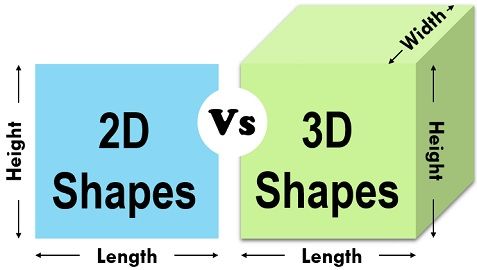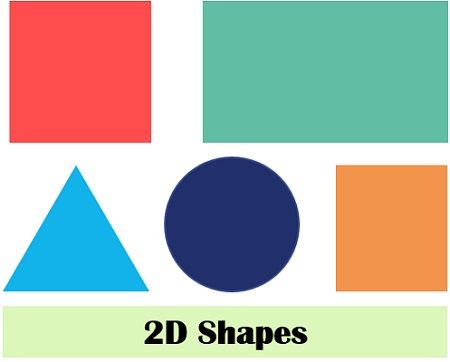 In 2D and 3D, the “D” specifies the dimensions involved in the shape. So, the primary difference between 2D and 3D shapes is that a 2D shape comprised of two dimensions that are length and width. As against, a 3D shape incorporates three dimensions that are length, width and height.
In 2D and 3D, the “D” specifies the dimensions involved in the shape. So, the primary difference between 2D and 3D shapes is that a 2D shape comprised of two dimensions that are length and width. As against, a 3D shape incorporates three dimensions that are length, width and height.
These are very common terms and frequently heard overtimes. We use 2 and 3 dimensions in several areas such as in engineering drawing, computer graphics, animations, and in real life too. In this article, we are going to understand the difference between 2D and 3D shapes.
Content: 2D Shapes Vs 3D Shapes
Comparison Chart
| Basis for comparison | 2D Shapes | 3D Shapes |
|---|---|---|
| Basic | Only 2 dimensions are there that are X and Y. | Three dimensions are there, X, Y and Z. |
| Constructs | Square, circle, triangle, rectangle, hexagon, etcetera. | Cube, sphere, cone, cuboid, etcetera. |
| Represents | Top view, side view, bottom view, front view while making engineering drawings. | Isometric and orthogonal shapes. |
| Involves | Length and breadth | Length, breadth and height |
| Ease of construction | Simple to create | Quite complex |
| Edges | Are completely visible in the drawings. | Not visible or hidden due to overlapping. |
Definition of 2D Shapes
We can consider that the shapes which can be produced on a flat surface are said to be 2D (dimensional) Shape. In other words, the shapes that only have length and width are the 2D shapes.
Now, what a 2D shape is? Before understanding the 2D shape, we must know what a 0D object is, which means there is no dimensions. A 0D shape is defined by a point.
Applications
All the parallel projections and one-point perspective projections in plans of some object are made in 2D. Geological maps also made in 2 dimensions, in which we use the method of contouring to show the depth with the help of different shapes, even in oceanography also.
Examples
There are various types of 2D shapes, among which some of them are shown below. The examples of 2D shapes cover majorly the drawings made on the wall, floor tiles, covers, fabrics etcetera.
The examples of 2D shapes cover majorly the drawings made on the wall, floor tiles, covers, fabrics etcetera.
Definition of 3D Shapes
3D shapes are solid shapes, unlike 2D shapes which are produced by combining 3 Dimensions – length, width and height. The real-life examples of these shapes are buildings, balls, boxes, anything that has 3 dimensions. Let’s consider a cuboidal building which is built with length, width and height is a 3D shape.
Applications
These are used in several applications, such as in 3D animations, 3D designing of some product building, bridge, tools, 3D graphs, maps etcetera. The 3D shapes help in showing the depth of the object. To illustrate the 3D in engineering, we use 2 and 3 point perspective projection and orthographic projection.
Examples
The shapes included in 3D shapes are sphere, cube, cone, cuboid, pyramid, and so on and the below-given diagram represents the 3D shapes. These days this 3D designing is employed in the 3D printing of products.
These days this 3D designing is employed in the 3D printing of products.
Key Differences Between 2D and 3D Shapes
- The prior difference between the 2D and 3D shapes is that in 2D shapes only two axis are incorporated x and y-axis. On the other hand, in 3D shapes, the three axis x, y and z-axis are covered.
- Square, circle, triangle, rectangle are the various 2D shapes while cube, sphere, cuboid, are the 3D shapes.
- The plan in engineering drawing, which represents in top view, front view side view of some object are made in 2D. Hence we use 2D shapes in these type of plans. Conversely, for representing three dimensions, the isometric and orthographic projections are used for rendering the 3D objects.
- We can use the manual or automatic methods of creating the 2D and 3D shapes, and there are several softwares used for doing this. However, 2D shapes are easy to create, whereas 3D shapes are challenging to build.
- The 2D shapes show all the edges of that shape, but in 3D shapes, these edges could be hidden. For example, in a square, all the edges are visible. However, if we take an example of the cube, then, it is not possible to display all of its edges from one angle.
Conclusion
From the above discussion, the basic difference between 2D and 3D shapes must be clear to you. So, 2D shapes are elementary flat shapes and have only 2 dimensions – x and y-axis. In contrast, 3D shapes contain three dimensions – x, y and z, in other terms these shapes have the volume too.
visitacion odtohan says
This is very helpful to me as reference for my module. Thank you so much for publishing it.
Tiger shroof says
The answer are correct but there are some words that were very diffcuilt to understand
Raeya says
very right
Gopi patel says
I have been wondering about this topic of late and was thinking of searching the internet to increase my knowledge. Thank God that I visited your website otherwise I wouldn’t have come across such a nicely-written article. Once I liked this particular post, I was going through few other posts as well. I simply loved them! Kudos to the writers who work hard to write these.
Sara Zytelewska says
i like this
Jabir hussaini says
It’s Good to cover this information.
Thank all who advised about this💪